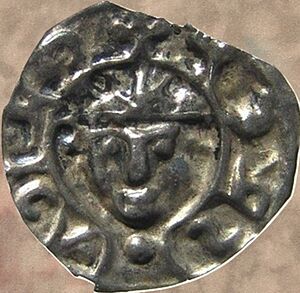John I of Sweden facts for kids
Quick facts for kids John I |
|
|---|---|
| King of Sweden | |
| Reign | 1216 – 10 March 1222 |
| Predecessor | Eric X |
| Successor | Eric XI |
| Born | c. 1201 |
| Died | 10 March 1222 Visingsö, Sweden |
| House | Sverker |
| Father | Sverker II of Sweden |
| Mother | Ingegerd Birgersdotter |
John I (Swedish: Johan Sverkersson) was the king of Sweden from 1216 until he died in 1222. He was born around 1201.
Early Life and Family
John I was the son of King Sverker II of Sweden and Queen Ingegerd. His family was known as the House of Sverker.
When John was just one year old, his grandfather, Jarl Birger Brosa, passed away. A jarl was a very important leader, similar to a duke. King Sverker II decided to make his baby son, John, a jarl. He did this to make his own power stronger. This made the rival House of Eric very angry. They even made fun of John, calling him the "breech-less jarl" because he was so young.
John kept his title as jarl until his father, King Sverker, lost a big battle called the Battle of Lena in 1208. Later, King Sverker was killed in the Battle of Gestilren in 1210. After this, Erik Knutsson from the House of Eric became the new king, Eric X of Sweden.
Becoming King
In 1216, King Eric X suddenly died from a fever. Even though he had a young son, the powerful Swedish nobles chose the teenage John to be the next king. This decision went against the wishes of the Pope in Rome. The Danish King Valdemar Sejr also disagreed with their choice, because Eric X's son was his nephew.
In Sweden, becoming king was not easy. The Church had a big say in who became ruler. John had many important church leaders on his side. These included Archbishop Valerius and Bishop Karl of Linköping. Bishop Karl was also called the "chancellor," which was a new and important title in Sweden at that time.
John was crowned king in 1219. Right away, he gave special rights to the Swedish bishops. He confirmed the rights his father, Sverker II, had given them in 1200, but he made them even better. For example, the Church's land would not have to pay royal taxes. Also, any fines paid by people living on Church land would go to the bishops. He also gave some royal farms to church leaders.
Expedition to Estonia
During King John's short time as king, Sweden started to have a presence in Estonia. At this time, German knights (the Order of the Sword Brothers) and the Danish King Valdemar Sejr were active in the Baltic region. The Swedish nobles wanted to join in and gain some land too.
In 1220, a Swedish army set sail. King John himself, his cousin Jarl Karl Döve, and his chancellor Bishop Karl Magnusson led the ships to Rotalia in Estonia.
At first, the trip was successful. King John set up a base in Leal (Lihula). From this base, Swedish soldiers explored the area, built churches, and made the local people accept baptism. After this, the king returned home.
However, the expedition ended badly. On August 8, 1220, people from Ösel attacked the Swedish base in the Battle of Lihula. Bishop Karl and Jarl Karl Döve were killed, along with almost all the Swedish defenders. This terrible defeat meant Sweden had no presence in Estonia for more than 300 years. These events were written about in old books like the Chronicle of Henry of Livonia.
Death and Legacy
King John I remained on the throne until his death on March 10, 1222. He died unmarried and had no children.
People in Sweden remembered him fondly. They said he was "young of years and very gentle." They also said that "All of Sweden deeply mourned his death, that he was not allowed a longer life." He was buried in Alvastra.
In the same year John died, 1222, the young heir from the rival family, Erik Eriksson, became king at the age of six. He reigned as King Eric XI of Sweden.
See also
 In Spanish: Juan I Sverkersson para niños
In Spanish: Juan I Sverkersson para niños


